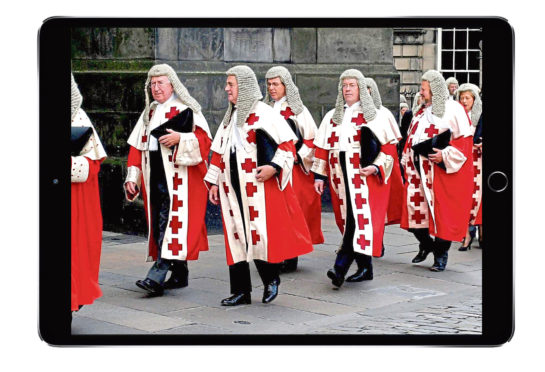
Scotland’s prosecutors have been armed with £1 million of computer tablets as the courts move into the modern age.
Two hundred iPads have been handed out during a national rollout that concluded last week, five years after it was first announced.
The delayed project, first announced in 2013, is now complete, we can reveal.
Deputes can now upload information about a case to an iPad app and send it to the Procurator Fiscal’s office straight away using a secure wifi system.
It means there is no need to carry hundreds of paper files between courts, reducing security risks.
The Case Management in Court (CMiC) app is not directly connected to the Crown Office database and the iPad is automatically wiped if stolen.
The iPads also have a secret three-step security system that is impossible to get past, according to project manager Amanda Hollis, who has spearheaded the digital transformation of the Crown Office and Procurator Fiscal Service.
She said: “It’s different from a standard iPad. If someone got their hands on it, it would be automatically wiped if someone tried to breach security credentials.
“It’s far more secure than having bits of paper travelling around the courts. It’s also a completely secure wifi network that was subject to external penetration tests.”
Ms Hollis said the digital transformation was a “revelation”.
“We have issued more than 200 iPads to deputes all over the country. We started the process in November and it has been very, very positive. The iPad itself gives them more up-to-date information. In court they have live information available and can record information in real time.
“It gives victims and witnesses greater access to information as the court proceeds.”
The iPads are currently used in courts dealing with more minor offences – known as summary proceedings – but it is expected they will eventually be used in all court cases.
Angela Farrell, assistant procurator fiscal for Glasgow, who oversees a team of 39 fiscal deputes, first used an iPad in court two weeks ago.
She said: “There were 81 cases that day, so it was far more efficient than having files. I was amazed how much better it was.”
Glasgow Sheriff Court is one of the busiest in Europe and Mrs Farrell hoped more cases could now be heard because the iPads could be updated in real time, meaning there is no need to wait for additional paperwork.
She said: “The deputes love it so we’re going to expand it to sheriff pleading diets and justice of the peace custodies.”
However, she admitted some more senior fiscal deputes in Scotland had been a bit uncomfortable with the shift away from paper files.
Mrs Farrell said: “They’re not familiar with it, so they are worried they may not get through the procedural court quick enough.
“But every depute was given time to get used to it.
“And we have somebody with them who is more comfortable, just for the first half-hour of the court. ”
But fiscal deputes won’t be able to use the iPad to access social media websites, stream TV shows or catch up on the news between court cases.
“The iPads can only be used to access the CMiC system,” added project manager Amanda Hollis.

Enjoy the convenience of having The Sunday Post delivered as a digital ePaper straight to your smartphone, tablet or computer.
Subscribe for only £5.49 a month and enjoy all the benefits of the printed paper as a digital replica.
Subscribe